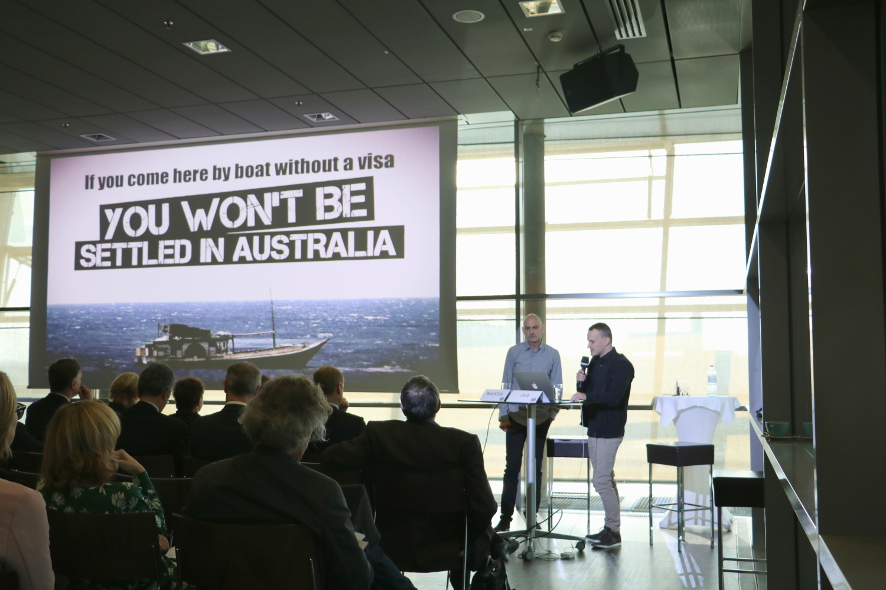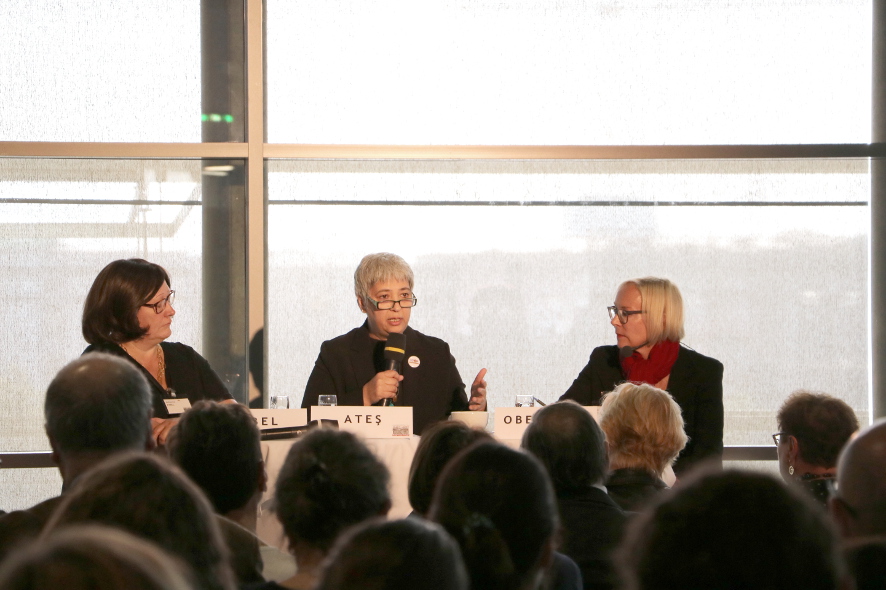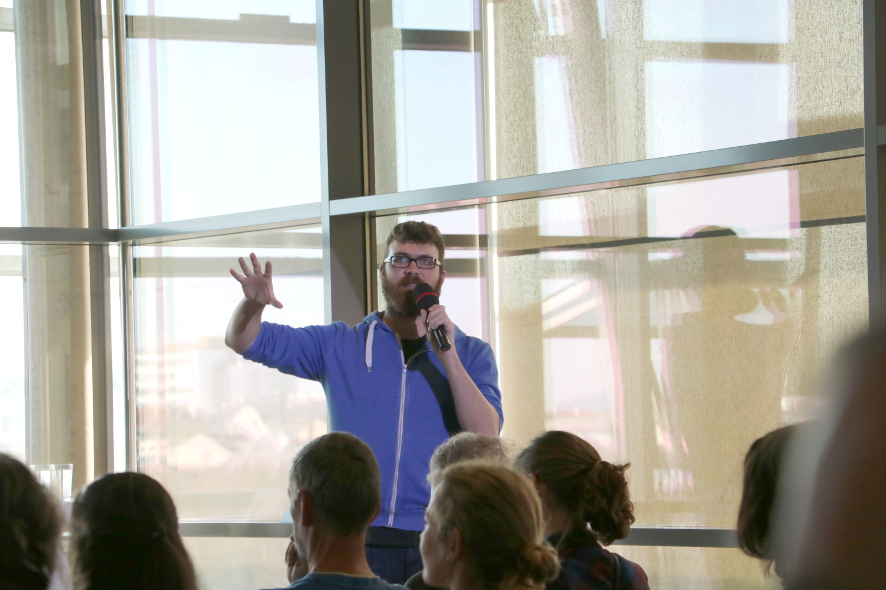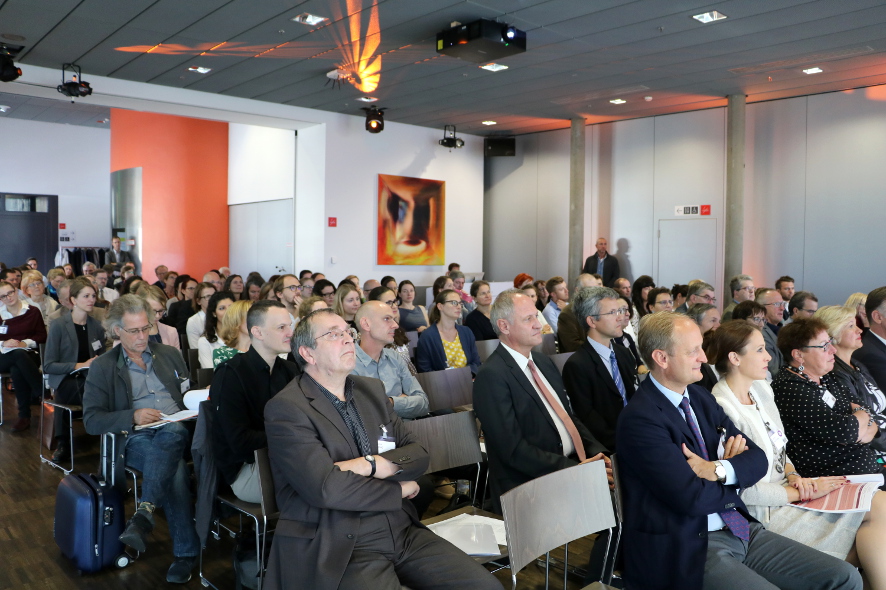In 1867—exactly 150 years ago—the catalog of fundamental rights went into effect in the Austrian Constitution (Staatsgrundgesetz). And every two years since 2007, this country has observed a Fundamental Rights Day, a chance for people to discuss the latest social developments and their effects on basic human rights.
Fundamental Rights Day 2017 was held by the Association of Austrian Judges, Johannes Kepler University Linz and Ars Electronica at the Ars Electronica Center’s Sky Loft. Participants focused on a matter that is as sensitive as it is provocative: Whether, in light of changed social framework conditions, human rights as we conventionally conceive of them have become a luxury that we can no longer afford. In open, critical discussions over the course of a two-day symposium, speakers elaborated on the challenges that the current situation poses to the mission to which Austrian judges are committed: the protection of fundamental rights.
The first speaker, cultural studies scholar Thomas Macho, was followed by two faces very familiar to fans of Ars Electronica. Christoph Wachter and Mathias Jud, recipients of the 2016 Golden Nica in the Prix Ars Electronica’s Interactive Art category, offered insights into a series of digital arts projects in which numerous activists worldwide are involved.

What role does art play in conjunction with the subject of human rights?
Christoph Wachter: In preparing my remarks for today’s conference, I was fascinated by how difficult it actually has become to strictly differentiate among the individual aspects of fundamental rights, especially in conjunction with digital communications. This buzzword is such a complex concept that, I believe, it’s hard for us to even imagine all that it entails. But, in fact, these digitization & communications situations intersect all aspects of our existence.
Nowadays, we often conceive of digital communication as a threat. But we can’t exclude ourselves from this. On one hand, we’re unable to do so because it pervades all areas of everyday life; on the other hand, we can’t shut this out of our lives because we’re social, communicative beings and we rely upon communication. We’re dependent on being perceived by other members of society.

In the day’s first panel discussion, Katharina Pabel, dean of Johannes Kepler University School of Law, and Seyran Ateş, a Turkish-Kurdish attorney, author and women’s rights activist, talked about the collision of fundamental rights in the encounters of cultures and religions. We followed up their discussion by posing a few questions to Ms. Ateş.
How exactly do you define a conflict of fundamental rights—first and foremost with respect to culture and religion?
Seyran Ateş: A conflict of fundamental rights occurs when a fundamental right—or basic freedom such as the right to exercise ones profession, or parents’ right to raise their children as they see fit—conflicts with another right—for instance, the right to practice ones religion or the right of gender equality. When two fundamental rights are involved, it’s necessary to establish a practical concordance. One must consider which of the fundamental rights is more important than the other in the particular sociopolitical context. Then, after weighing all relevant factors, one decides, for example, it’s much more important to preserve the neutrality of the state. In decisions having to do with wearing a headscarf (hijab), it’s perhaps simple to explain that, here, courts in several instances have said that religious freedom comes before neutrality, or that neutrality isn’t as important as a woman’s right to wear a headscarf, since freedom of religion is such an important provision for us.
You also mentioned the mosque that you established …
Seyran Ateş: Yes, we founded a mosque in which mostly liberal Muslims gather, where men and women pray together, and women are not compelled to wear headscarves. The can decide for themselves if they want to wear them or not. They’re neither prohibited nor mandatory. A woman may also lead the congregation in prayer as well as preach the sermon. In other words, we have broken with conservative-fundamentalist traditions. As a result, I’ve been the target of so many death threats via social media that the State Police have recognized the necessity of giving me round-the-clock protection. But there are also people who are saying: “This is the last straw! We’re sick and tired of hearing that our religion is only connected with terror. What you’re doing is great! We men can follow a wise person, even if that person is a woman.”

Following a lunch break, the conclave continued with a panel entitled “Digital Is Better: Young People, Internet Culture and the Interplay of Law and Actual Practice”. Matthias Rohrer and Thomas Lohninger talked about the opportunities and risks of digital media, the legal framework conditions, and sensible, responsible dealings with the digital worlds that are part of the everyday life of young citizens. We talked about fake news with Matthias Rohrer, a scholar of youth culture.
The term “fake news” was recently taken up into one of the German language’s most authoritative dictionaries. How should people—above all, young people—deal with fake news?
Matthias Rohrer: Basically speaking, our problem is that it’s increasingly difficult to verify things. If you consider the torrent of information that engulfs us nowadays—and that applies not only to kids and young adults—then we have hardly any time to somehow filter this material, to vet it, and assess whether the information is correct or not. Thus, what I regard as the essential point is creating a consciousness of how to deal with digital information and getting into the habit of arriving at an informed opinion about the information’s veracity. Young people have to be equipped with tools they can use to check information and evaluate it. That’s the key point.

A fascinating and informative first symposium day concluded with an evening presentation in Deep Space and a Highlight Tour through the Ars Electronica Center’s current exhibitions.
